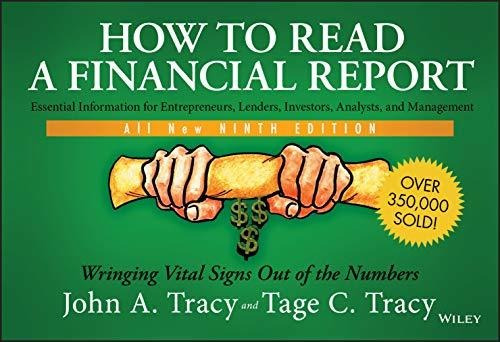Book : How To Read A Financial Report Wringing Vital Signs.
Pagá en cuotas
Llega gratis el miércoles 12 de junio
Retirá gratis entre el 12 y el 17/jun en correo y otros puntos
Ver en el mapaDisponible 15 días después de tu compra
MercadoLíder | +10mil ventas
MercadoLíder Platinum
+10mil
Ventas concretadas
Brinda buena atención


Descripción
- ANTES DE COMPRAR PREGUNTE FECHA DE ENTREGA.
- ENVIAMOS POR MERCADOENVIOS
- PUEDE RETIRAR POR AHORA SOLO POR QUILMES, MICROCENTRO ESTA CERRADO, POR ESO...
- EN CABA (CAPITAL FEDERAL) ENVIAMOS SIN CARGO ESTE PRODUCTO.
- FORMA DE PAGO : MERCADOPAGO
- HACEMOS FACTURA A.
- ELBAZARDIGITAL VENDEDOR PLATINUM
- TODOS NUESTROS PRODUCTOS EN:
https://eshops.mercadolibre.com.ar/elbazardigital
-X-X-X-
- SOMOS IMPORTADORES DIRECTOS, ESTE PRODUCTO SE COMPRA Y SE IMPORTA DESDE ESTADOS UNIDOS, ESTO IMPLICA QUE USTED ESTA COMPRANDO EL MISMO PRODUCTO QUE COMPRARÍA UN CLIENTE DE ESE PAÍS.
- ANTES DE REALIZAR UNA CONSULTA, VISUALICE TODAS LAS IMAGENES DEL PRODUCTO.
Descripción provista por la editorial :
The updated new edition of the comprehensive guide to reading and understanding financial reportsFinancial reports are used to provide a range of vital information, including an organization’s cash flow, financial condition, and profit performance (aka The Big Three Financial Statements). Financial statements are often complex and extremely difficult to understand for anyone other than accounting and finance professionals. How to Read a Financial Report enablesinvestors, lenders, business leaders, analysts, and managers to read, analyze, and interpret financial accounting reports. Designed specifically for non-specialists, this reader-friendly resource covers the fundamentals of financial reporting in jargon-free English. Topics such as sales revenue & recognition, costs of goods sold, sources & uses of capital/cash, non-cash expenses (e.g., depreciation expense), income tax obligations, understanding profits & financial stability, and financial statement ratios & analysis are covered throughout the book.Now in its ninth edition, this bestselling guide has been thoroughly revised to reflect changes in accounting and financial reporting rules, current practices, and recent trends. New and expanded content explains managing cash flow, illustrates the deceitful misrepresentation of profits in some financial reports (aka Financial Engineering), and more. Further, end-of-chapter activities help readers learn the intricacies of the balance sheet and cash flow statement, while updated sections address shifts in regulatory standards. Written by two highly experienced experts in financial accounting, this resource: Enables readers to cut through the noise and focus on what financial reports and financial statements are really saying about a companyClarifies commonly misunderstood aspects of financial reporting and how companies can “financially engineer” operating resultsOffers comprehensive, step-by-step guidance on analyzing financial reportsProvides numerous examples and explanations of various types of financial reports and analysis tools From the Inside Flap THE NON-ACCOUNTANTS GUIDE TO UNDERSTANDING FINANCIAL DATAFinancial statements are full of vital information about a companys current health and future prospects. Managers, investors, and others need to understand these reports, which sometimes seem to be written in a foreign language that only accountants can speak. Now in its ninth edition, How to Read a Financial Report continues its 40-year tradition of breaking through that language barrier and providing a plain-English users guide to financial reports. This edition reflects recent changes to accounting rules, maintaining its classic focus on helping readers interpret the interconnections among disparate pieces of financial data. From the Back Cover THE NON-ACCOUNTANTS GUIDE TO UNDERSTANDING FINANCIAL DATAFinancial statements are full of vital information about a companys current health and future prospects. Managers, investors, and others need to understand these reports, which sometimes seem to be written in a foreign language that only accountants can speak. Now in its ninth edition, How to Read a Financial Report continues its 40-year tradition of breaking through that language barrier and providing a plain-English users guide to financial reports. This edition reflects recent changes to accounting rules, maintaining its classic focus on helping readers interpret the interconnections among disparate pieces of financial data. About the Author JOHN A. TRACY is a professor of accounting, emeritus, at the University of Colorado at Boulder. Before his 35-year tenure at Boulder, he was on the business faculty at the University of California, Berkeley. John is the author of several best-selling books on accounting and finance. TAGE C. TRACY is the founder of TMK and Associates, a financial consulting firm focused on providing executive-level accounting, financial, a
-o-o-o-
Garantía del vendedor: 90 días
Preguntas y respuestas
¿Qué querés saber?
Preguntale al vendedor
Nadie hizo preguntas todavía. ¡Hacé la primera!

